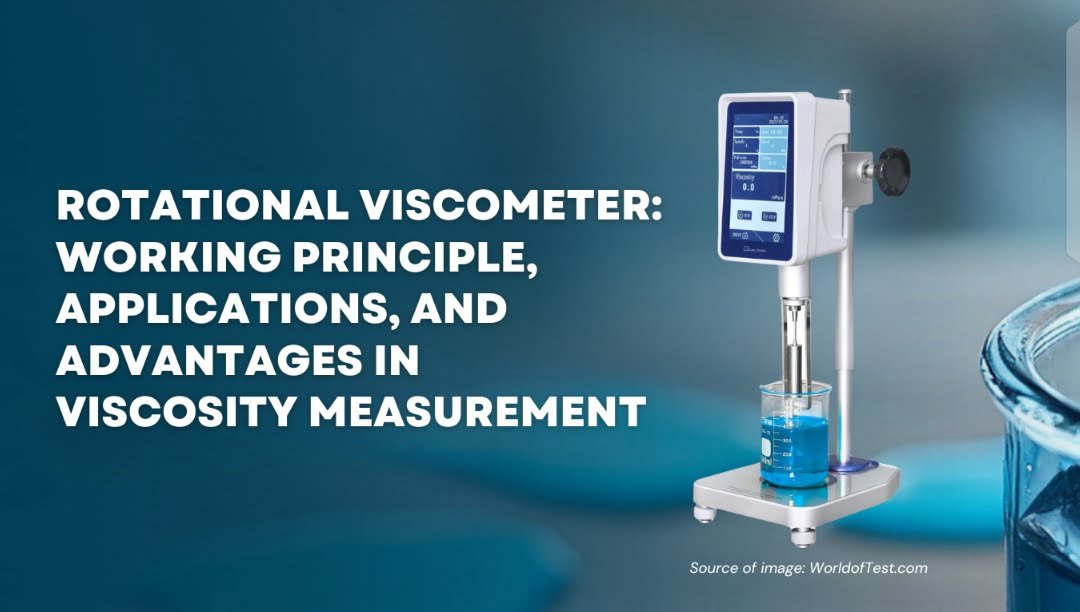Viscosity is one of the most important physical properties of fluids in a variety of industries, from food and beverages to pharmaceuticals to oil and gas. Viscosity measures the resistance of a fluid to flow, which can affect the production process, product quality, and final performance of a material.
To measure viscosity with precision, various tools have been developed, one of which is the rotational viscometer. This instrument is famous for its accuracy in measuring the viscosity of liquids that have non-Newtonian and Newtonian flow characteristics. This article will review the working principle, applications, and advantages of a rotational viscometer.
Definition Rotational Viscometer
A rotational viscometer is a tool that uses the principle of rotation to measure the viscosity of a fluid. This tool usually consists of two elements in the form of a spindle or rotating cylinder, with the fluid being measured filled into a container between the two spindles. Rotational Viscometers can measure variations in the viscosity of fluids ranging from liquid to semi-solid types.
Working Principle of Rotational Viscometer
Rotational viscometers work on the basic principle of measuring the torque required to rotate a spindle or cylinder in a fluid. The tool consists of a spindle connected to a drive motor, as well as a sensitive torque measurement system.
When the spindle is rotated in the fluid, the fluid provides resistance to the movement. The magnitude of this resistance depends on the viscosity of the fluid; The higher the viscosity, the greater the resistance the fluid gives to the spindle.
Rotational viscometers generally have adjustable rotational speed settings, so they can be used to measure viscosity at various flow conditions. The viscosity of a fluid can be determined by measuring the torque required to rotate the spindle in the fluid.
The measurement data between the torque, rotation speed, and dimensions of the spindle, is then converted into viscosity values.
Types of Rotational Viscometer
1. Brookfield Viscometer
It consists of two main components, namely a cup that contains fluid and a spindle/cylinder that rotates inside the cup. Viscosity is measured by monitoring the torque required to rotate the spindle at a constant speed. This type of viscometer is one of the most popular models of rotational viscometers.
2. Cone-and-Plate Viscometer
Using cones and plates to measure viscosity. The cone is rotated on a plate, with the liquid in between the two. It is highly sensitive and ideal for measuring the viscosity of small volumes of liquids
3. Coaxial Cylinder Viscometer
It consists of two concentric cylinders, in which the inner cylinder is rotated and the liquid is placed in the space between the two cylinders It is a highly precise tool and is used in research as well as industrial applications.
Spindle Type of Rotational Viscometers
1. Spindle Type L: Designed to measure the viscosity of low-viscosity liquids.
2. Spindle Type R: Suitable for measuring the viscosity of medium to high viscosity liquids.
3. Spindle Type H: Used for liquids with high viscosity.
Example of using the right type of spindle for fluid viscosity measurement
| Food and Beverages | Pharmaceuticals and Cosmetics | Oil and Petrochemical | |||
| Application | Spindle Type | Application | Spindle Type | Application | Spindle Type |
| Fruit Butter | H | Ointment | H | Lubricating Oil | R |
| Jelly | H | Syrup Medicine | R | Fuel Oil | L |
| Sauce | R | Antibiotic Creams | R | Cooking oil | R |
| Yogurt | R | Moisturizing Lotion | R | Coatings, Paints | R |
| Juice | L | Shampoo, Conditioner | R | Glue | H |
| Milk | L | Face Masks | H | Resin Epoxy | R |
Rotational Viscometer Applications
Rotational viscometers have a wide range of applications in various industries, especially in production processes that require strict quality control of the viscosity of materials. Here are some of the main applications of this tool:
1. Food and Beverage Industry
In this industry, viscosity is an important parameter that affects the texture, taste, and stability of a product.
2. Pharmaceuticals and Cosmetics
In the manufacture of medicines and cosmetic products, viscosity affects the formulation, stability, and application of the product.
3. Oil and Gas
In the oil and gas industry, viscosity is an important factor in the processing, transportation, and storage of crude oil and its derivative products.
4. Paint and Coatings Industry
The viscosity of paints and coatings affects their application, spread ability, and finish. Rotational viscometers are often used in the development and production of paints to ensure the quality of the final product.
Advantages and Disadvantages of Rotational Viscometers
Rotational viscometers have several advantages over other viscosity measurement methods. Here are some of them:
Advantages of Rotational Viscometers
1. High Accuracy: This instrument is capable of measuring viscosity with very high precision, even for liquids with non-Newtonian characteristics, where viscosity can change as the flow rate changes.
2. Flexibility: Rotational viscometers can be used to measure a wide range of liquids, from very dilute to very viscous.
3. Ease of Use: Despite having advanced technology, rotational viscometers are generally easy to use.
4. Ability to Measure Viscosity in Dynamic Conditions: Unlike static measurement methods, rotational viscometers can measure viscosity in dynamic conditions, where fluids are undergoing changes in velocity or force.
Disadvantages of Rotational Viscometers
1. Limitations on Non-Newtonian Fluids: Rotational viscometers may not provide consistent results for non-Newtonian fluids, whose viscosity changes with the rate of shearing.
2. The Need for Regular Calibration: To stay accurate, rotational viscometers need to be calibrated regularly.
3. Cost and Maintenance: Rotational viscometers tend to be more expensive than other simple types of viscometers, such as capillary viscometers.
Rotational viscometers are a very important tool in the industrial and research world for accurate viscosity measurements. With a simple but effective working principle, it provides flexibility and high precision in the measurement of different types of liquids.
Its wide application in various industrial sectors confirms the importance of rotational viscometers in ensuring product quality and consistency, as well as in scientific research. In this modern era, where product quality is a top priority, rotational viscometers remain the tool of choice for reliable and accurate viscosity measurement.






Be First to Comment